Begüm Demir
Technische Universität Berlin, Berlin Institute for the Foundations of Learning and Data
Seabed-Net: A multi-task network for joint bathymetry estimation and seabed classification from remote sensing imagery in shallow waters
Oct 22, 2025Abstract:Accurate, detailed, and regularly updated bathymetry, coupled with complex semantic content, is essential for under-mapped shallow-water environments facing increasing climatological and anthropogenic pressures. However, existing approaches that derive either depth or seabed classes from remote sensing imagery treat these tasks in isolation, forfeiting the mutual benefits of their interaction and hindering the broader adoption of deep learning methods. To address these limitations, we introduce Seabed-Net, a unified multi-task framework that simultaneously predicts bathymetry and pixel-based seabed classification from remote sensing imagery of various resolutions. Seabed-Net employs dual-branch encoders for bathymetry estimation and pixel-based seabed classification, integrates cross-task features via an Attention Feature Fusion module and a windowed Swin-Transformer fusion block, and balances objectives through dynamic task uncertainty weighting. In extensive evaluations at two heterogeneous coastal sites, it consistently outperforms traditional empirical models and traditional machine learning regression methods, achieving up to 75\% lower RMSE. It also reduces bathymetric RMSE by 10-30\% compared to state-of-the-art single-task and multi-task baselines and improves seabed classification accuracy up to 8\%. Qualitative analyses further demonstrate enhanced spatial consistency, sharper habitat boundaries, and corrected depth biases in low-contrast regions. These results confirm that jointly modeling depth with both substrate and seabed habitats yields synergistic gains, offering a robust, open solution for integrated shallow-water mapping. Code and pretrained weights are available at https://github.com/pagraf/Seabed-Net.
CSMoE: An Efficient Remote Sensing Foundation Model with Soft Mixture-of-Experts
Sep 17, 2025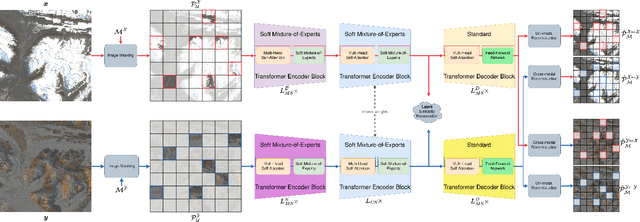
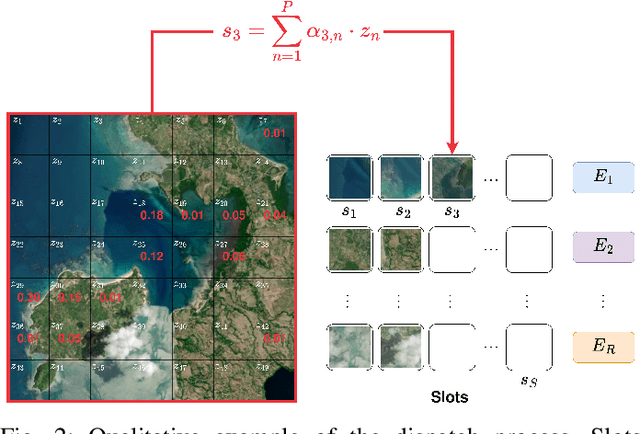

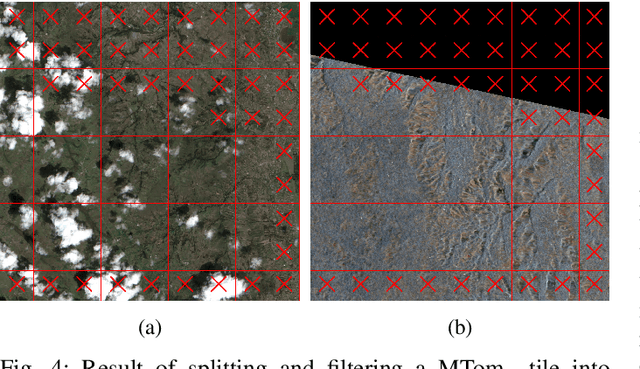
Abstract:Self-supervised learning through masked autoencoders has attracted great attention for remote sensing (RS) foundation model (FM) development, enabling improved representation learning across diverse sensors and downstream tasks. However, existing RS FMs often either suffer from substantial computational complexity during both training and inference or exhibit limited representational capacity. These issues restrict their practical applicability in RS. To address this limitation, we propose an adaptation for enhancing the efficiency of RS FMs by integrating the Soft mixture-of-experts (MoE) mechanism into the FM. The integration of Soft MoEs into the FM allows modality-specific expert specialization alongside shared cross-sensor representation learning. To demonstrate the effectiveness of our adaptation, we apply it on the Cross-Sensor Masked Autoencoder (CSMAE) model, resulting in the Cross-Sensor Mixture-of-Experts (CSMoE) model. In addition, we introduce a thematic-climatic descriptor-driven sampling strategy for the construction of a representative and diverse training set to train our CSMoE model. Extensive experiments on scene classification, semantic segmentation, and content-based image retrieval demonstrate that our adaptation yields a reduction in computational requirements while maintaining or improving representational performance. Compared to state-of-the-art RS FMs, CSMoE achieves a superior trade-off between representational capacity, accuracy, and computational efficiency. On average, CSMoE achieves more than twice the computational efficiency of existing RS FMs, while maintaining competitive performance across all experiments. These results show the effectiveness of the proposed adaptation for creating computationally efficient RS FMs. The code for the model, the training set creation, and the model weights will be available at https://git.tu-berlin.de/rsim/csmoe.
Sea-Undistort: A Dataset for Through-Water Image Restoration in High Resolution Airborne Bathymetric Mapping
Aug 11, 2025Abstract:Accurate image-based bathymetric mapping in shallow waters remains challenging due to the complex optical distortions such as wave induced patterns, scattering and sunglint, introduced by the dynamic water surface, the water column properties, and solar illumination. In this work, we introduce Sea-Undistort, a comprehensive synthetic dataset of 1200 paired 512x512 through-water scenes rendered in Blender. Each pair comprises a distortion-free and a distorted view, featuring realistic water effects such as sun glint, waves, and scattering over diverse seabeds. Accompanied by per-image metadata such as camera parameters, sun position, and average depth, Sea-Undistort enables supervised training that is otherwise infeasible in real environments. We use Sea-Undistort to benchmark two state-of-the-art image restoration methods alongside an enhanced lightweight diffusion-based framework with an early-fusion sun-glint mask. When applied to real aerial data, the enhanced diffusion model delivers more complete Digital Surface Models (DSMs) of the seabed, especially in deeper areas, reduces bathymetric errors, suppresses glint and scattering, and crisply restores fine seabed details. Dataset, weights, and code are publicly available at https://www.magicbathy.eu/Sea-Undistort.html.
FedX: Explanation-Guided Pruning for Communication-Efficient Federated Learning in Remote Sensing
Aug 08, 2025Abstract:Federated learning (FL) enables the collaborative training of deep neural networks across decentralized data archives (i.e., clients), where each client stores data locally and only shares model updates with a central server. This makes FL a suitable learning paradigm for remote sensing (RS) image classification tasks, where data centralization may be restricted due to legal and privacy constraints. However, a key challenge in applying FL to RS tasks is the communication overhead caused by the frequent exchange of large model updates between clients and the central server. To address this issue, in this paper we propose a novel strategy (denoted as FedX) that uses explanation-guided pruning to reduce communication overhead by minimizing the size of the transmitted models without compromising performance. FedX leverages backpropagation-based explanation methods to estimate the task-specific importance of model components and prunes the least relevant ones at the central server. The resulting sparse global model is then sent to clients, substantially reducing communication overhead. We evaluate FedX on multi-label scene classification using the BigEarthNet-S2 dataset and single-label scene classification using the EuroSAT dataset. Experimental results show the success of FedX in significantly reducing the number of shared model parameters while enhancing the generalization capability of the global model, compared to both unpruned model and state-of-the-art pruning methods. The code of FedX will be available at https://git.tu-berlin.de/rsim/FedX.
Continual Self-Supervised Learning with Masked Autoencoders in Remote Sensing
Jun 26, 2025Abstract:The development of continual learning (CL) methods, which aim to learn new tasks in a sequential manner from the training data acquired continuously, has gained great attention in remote sensing (RS). The existing CL methods in RS, while learning new tasks, enhance robustness towards catastrophic forgetting. This is achieved by using a large number of labeled training samples, which is costly and not always feasible to gather in RS. To address this problem, we propose a novel continual self-supervised learning method in the context of masked autoencoders (denoted as CoSMAE). The proposed CoSMAE consists of two components: i) data mixup; and ii) model mixup knowledge distillation. Data mixup is associated with retaining information on previous data distributions by interpolating images from the current task with those from the previous tasks. Model mixup knowledge distillation is associated with distilling knowledge from past models and the current model simultaneously by interpolating their model weights to form a teacher for the knowledge distillation. The two components complement each other to regularize the MAE at the data and model levels to facilitate better generalization across tasks and reduce the risk of catastrophic forgetting. Experimental results show that CoSMAE achieves significant improvements of up to 4.94% over state-of-the-art CL methods applied to MAE. Our code is publicly available at: https://git.tu-berlin.de/rsim/CoSMAE.
Redundancy-Aware Pretraining of Vision-Language Foundation Models in Remote Sensing
May 16, 2025Abstract:The development of foundation models through pretraining of vision-language models (VLMs) has recently attracted great attention in remote sensing (RS). VLM pretraining aims to learn image and language alignments from a large number of image-text pairs. Each pretraining image is often associated with multiple captions containing redundant information due to repeated or semantically similar phrases, resulting in increased pretraining and inference time. To overcome this, we introduce a weighted feature aggregation (WFA) strategy for VLM pretraining in RS. Our strategy aims to extract and exploit complementary information from multiple captions per image while reducing redundancies through feature aggregation with importance weighting. To calculate adaptive importance weights for different captions of each image, we propose two techniques: (i) non-parametric uniqueness and (ii) learning-based attention. In the first technique, importance weights are calculated based on the bilingual evaluation understudy (BLEU) scores of the captions to emphasize unique sentences and reduce the influence of repetitive ones. In the second technique, importance weights are learned through an attention mechanism instead of relying on hand-crafted features. The effectiveness of the proposed WFA strategy with the two techniques is analyzed in terms of downstream performance on text-to-image retrieval in RS. Experimental results show that the proposed strategy enables efficient and effective pretraining of VLMs in RS. Based on the experimental analysis, we derive guidelines for selecting appropriate techniques depending on downstream task requirements and resource constraints. The code of this work is publicly available at https://git.tu-berlin.de/rsim/redundacy-aware-rs-vlm.
Deep Learning-based Bathymetry Retrieval without In-situ Depths using Remote Sensing Imagery and SfM-MVS DSMs with Data Gaps
Apr 15, 2025

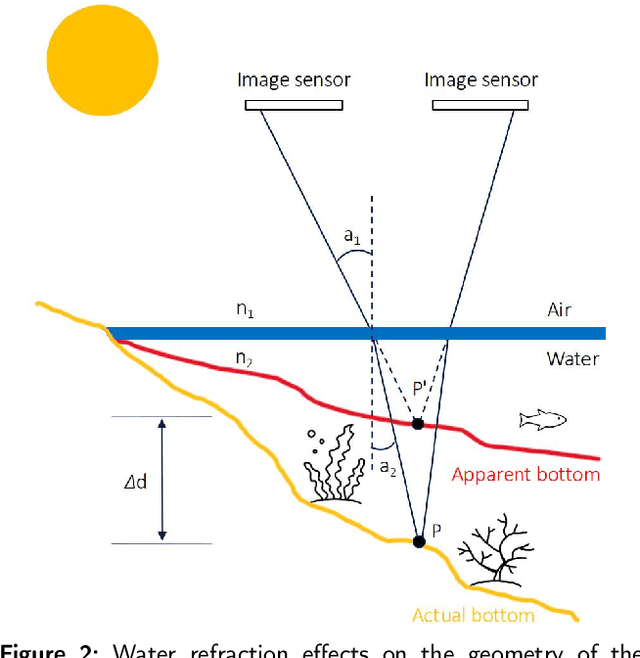

Abstract:Accurate, detailed, and high-frequent bathymetry is crucial for shallow seabed areas facing intense climatological and anthropogenic pressures. Current methods utilizing airborne or satellite optical imagery to derive bathymetry primarily rely on either SfM-MVS with refraction correction or Spectrally Derived Bathymetry (SDB). However, SDB methods often require extensive manual fieldwork or costly reference data, while SfM-MVS approaches face challenges even after refraction correction. These include depth data gaps and noise in environments with homogeneous visual textures, which hinder the creation of accurate and complete Digital Surface Models (DSMs) of the seabed. To address these challenges, this work introduces a methodology that combines the high-fidelity 3D reconstruction capabilities of the SfM-MVS methods with state-of-the-art refraction correction techniques, along with the spectral analysis capabilities of a new deep learning-based method for bathymetry prediction. This integration enables a synergistic approach where SfM-MVS derived DSMs with data gaps are used as training data to generate complete bathymetric maps. In this context, we propose Swin-BathyUNet that combines U-Net with Swin Transformer self-attention layers and a cross-attention mechanism, specifically tailored for SDB. Swin-BathyUNet is designed to improve bathymetric accuracy by capturing long-range spatial relationships and can also function as a standalone solution for standard SDB with various training depth data, independent of the SfM-MVS output. Experimental results in two completely different test sites in the Mediterranean and Baltic Seas demonstrate the effectiveness of the proposed approach through extensive experiments that demonstrate improvements in bathymetric accuracy, detail, coverage, and noise reduction in the predicted DSM. The code is available at https://github.com/pagraf/Swin-BathyUNet.
A Plasticity-Aware Method for Continual Self-Supervised Learning in Remote Sensing
Mar 31, 2025Abstract:Continual self-supervised learning (CSSL) methods have gained increasing attention in remote sensing (RS) due to their capability to learn new tasks sequentially from continuous streams of unlabeled data. Existing CSSL methods, while learning new tasks, focus on preventing catastrophic forgetting. To this end, most of them use regularization strategies to retain knowledge of previous tasks. This reduces the model's ability to adapt to the data of new tasks (i.e., learning plasticity), which can degrade performance. To address this problem, in this paper, we propose a novel CSSL method that aims to learn tasks sequentially, while achieving high learning plasticity. To this end, the proposed method uses a knowledge distillation strategy with an integrated decoupling mechanism. The decoupling is achieved by first dividing the feature dimensions into task-common and task-specific parts. Then, the task-common features are forced to be correlated to ensure memory stability while the task-specific features are forced to be de-correlated facilitating the learning of new features. Experimental results show the effectiveness of the proposed method compared to CaSSLe, which is a widely used CSSL framework, with improvements of up to 1.12% in average accuracy and 2.33% in intransigence in a task-incremental scenario, and 1.24% in average accuracy and 2.01% in intransigence in a class-incremental scenario.
A Multi-Modal Federated Learning Framework for Remote Sensing Image Classification
Mar 13, 2025Abstract:Federated learning (FL) enables the collaborative training of deep neural networks across decentralized data archives (i.e., clients) without sharing the local data of the clients. Most of the existing FL methods assume that the data distributed across all clients is associated with the same data modality. However, remote sensing (RS) images present in different clients can be associated with diverse data modalities. The joint use of the multi-modal RS data can significantly enhance classification performance. To effectively exploit decentralized and unshared multi-modal RS data, our paper introduces a novel multi-modal FL framework for RS image classification problems. The proposed framework comprises three modules: 1) multi-modal fusion (MF); 2) feature whitening (FW); and 3) mutual information maximization (MIM). The MF module employs iterative model averaging to facilitate learning without accessing multi-modal training data on clients. The FW module aims to address the limitations of training data heterogeneity by aligning data distributions across clients. The MIM module aims to model mutual information by maximizing the similarity between images from different modalities. For the experimental analyses, we focus our attention on multi-label classification and pixel-based classification tasks in RS. The results obtained using two benchmark archives show the effectiveness of the proposed framework when compared to state-of-the-art algorithms in the literature. The code of the proposed framework will be available at https://git.tu-berlin.de/rsim/multi-modal-FL.
GAIA: A Global, Multi-modal, Multi-scale Vision-Language Dataset for Remote Sensing Image Analysis
Feb 13, 2025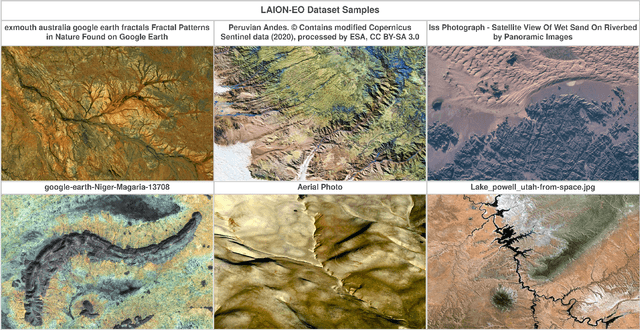
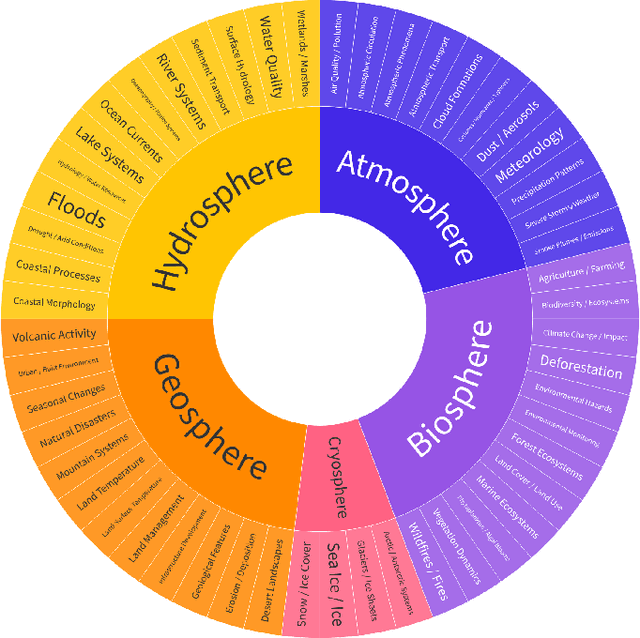
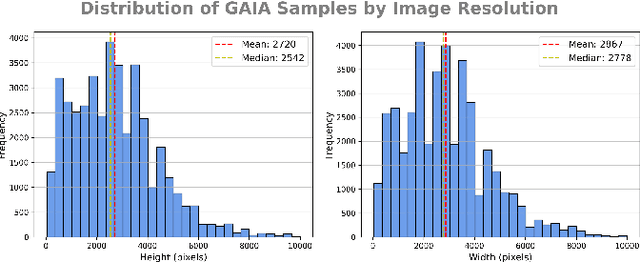
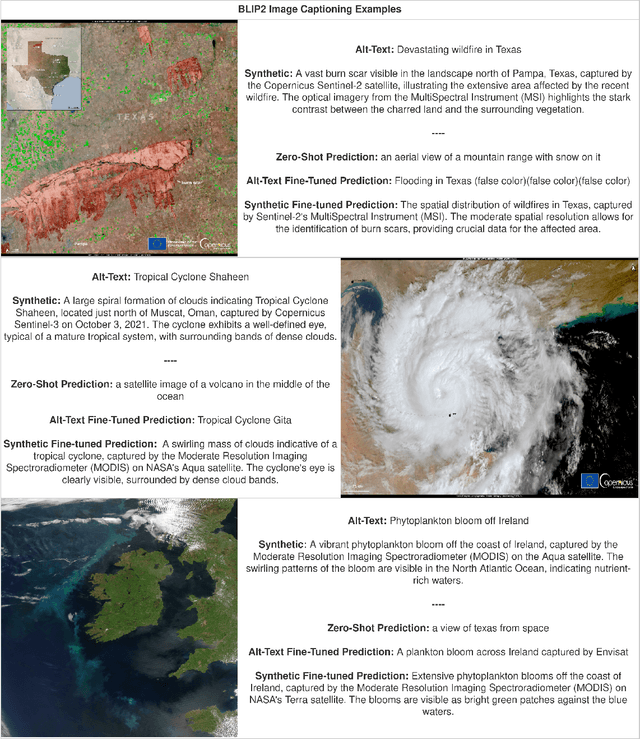
Abstract:The continuous operation of Earth-orbiting satellites generates vast and ever-growing archives of Remote Sensing (RS) images. Natural language presents an intuitive interface for accessing, querying, and interpreting the data from such archives. However, existing Vision-Language Models (VLMs) are predominantly trained on web-scraped, noisy image-text data, exhibiting limited exposure to the specialized domain of RS. This deficiency results in poor performance on RS-specific tasks, as commonly used datasets often lack detailed, scientifically accurate textual descriptions and instead emphasize solely on attributes like date and location. To bridge this critical gap, we introduce GAIA, a novel dataset designed for multi-scale, multi-sensor, and multi-modal RS image analysis. GAIA comprises of 205,150 meticulously curated RS image-text pairs, representing a diverse range of RS modalities associated to different spatial resolutions. Unlike existing vision-language datasets in RS, GAIA specifically focuses on capturing a diverse range of RS applications, providing unique information about environmental changes, natural disasters, and various other dynamic phenomena. The dataset provides a spatially and temporally balanced distribution, spanning across the globe, covering the last 25 years with a balanced temporal distribution of observations. GAIA's construction involved a two-stage process: (1) targeted web-scraping of images and accompanying text from reputable RS-related sources, and (2) generation of five high-quality, scientifically grounded synthetic captions for each image using carefully crafted prompts that leverage the advanced vision-language capabilities of GPT-4o. Our extensive experiments, including fine-tuning of CLIP and BLIP2 models, demonstrate that GAIA significantly improves performance on RS image classification, cross-modal retrieval and image captioning tasks.
 Add to Chrome
Add to Chrome Add to Firefox
Add to Firefox Add to Edge
Add to Edge